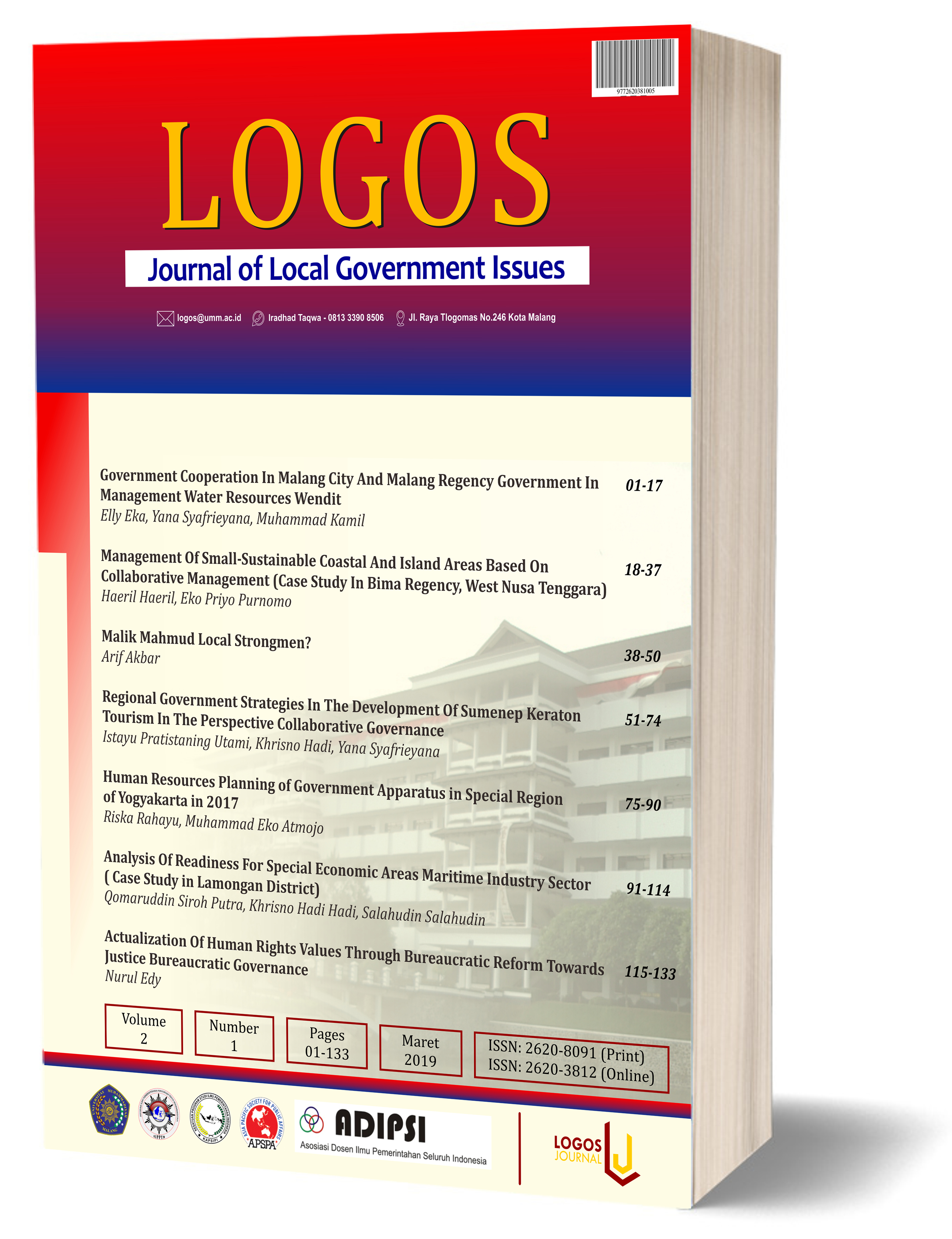Regional Government Strategies in the Development of Sumenep Keraton Tourism in the Perspective Collaborative Governance
DOI:
https://doi.org/10.22219/logos.Vol2.No1.51-74Abstract
Sumenep Regency has high tourism potential where there are about 32 tourist attractions in which one of them is Sumenep Palace. However, in 2016 Sumenep Palace is still less touristy compared to other tourist attractions such as Lombang Beach which can attract around 66.000 tourists, while Sumenep Palace is only around 49.000. In addition, some travel agents also still do little tourism promotion, because they prefer to offer beach tour packages. Therefore, in order for tourism development to run optimally, Sumenep Regency carries out a collaborative strategy involving the private sector and the community. The research method used was the descriptive qualitative method to provide an overview of the strategy of Sumenep Regency Government in developing tourism of Sumenep Palace based on collaborative strategy. Data collection techniques are carried out through the process of observation, interviews, and documentation. The theory used is collaborative governance by Chriss Ansell and Alisson Gash which emphasizes that collaboration is carried out formally between government and non-government actors, where the government becomes the initiator in the collaboration. The results showed that the collaboration included government actors carried out by Disparbudpora, travel tourism agents and klenengan art groups. Each of these actors has acted as a facilitator, carried out tourism promotions, and supported the implementation of collaboration activities. The achievements of collaborative activities indicate the presence of increasing tourist visits from 2016 to 2017, but in terms of regional revenue, the contribution is still not that significant. Overall, the realization of the collaboration is supported by a forum for dialogue, trust, and commitment between actors. But there are some drawbacks in the absence of regulations to support the collaboration process, the absence of hotel and restaurant involvement and the lack of involvement of travel agents.
Key Word: Government Strategy, Collaborative Governance, Tourism Development
Downloads
References
Ansell, C. and A. Gash (2008). "Collaborative Governance in Theory and Practice." Journal of public administration research and theory 18(4): 543-571.
Dwiyanto, A. (2005). Mewujudkan Good Governance melalui Pelayanan Publik, Gadjah Mada University Press.
Emerson, K. and T. Nabatchi (2015). Collaborative Governance Regimes, Georgetown University Press.
Hardini, H. K. (2018). "Government Strategic Collaborative Partnership in Tourism Affairs (Study in Malang and Batu City Governments)."
Hax, A. C. and N. S. Majluf (1988). "The Concept of Strategy and The Strategy Formation Process." Interfaces 18(3): 99-109.
Iorio, M. and A. Corsale (2014). "Community- Based Tourism and Networking: Viscri, Romania." Journal of Sustainable Tourism 22(2): 234-255.
J Salusu, M. (2015). Pengambilan Keputusan Stratejik, Gramedia Widiasarana.
Kertonegoro, S. (1994). "Manajemen Organisasi." Jakarta (ID): Widya Press Jakarta.
Kurniawan, F. (2013). "Kemitraan Pengelolaan Sektor Pariwisata (Studi Pada Tirta Wisata Kabupaten Jombang)." Jurnal Administrasi Publik 1(1): 47-55.
Downloads
Published
How to Cite
Issue
Section
License
Copyright (c) 2019 Istayu Pratistaning Utami, Khrisno Hadi, Yana Syafrieyana

This work is licensed under a Creative Commons Attribution-ShareAlike 4.0 International License.
Authors who publish with this journal agree to the following terms:
- Authors retain copyright and grant the journal right of first publication with the work simultaneously licensed under a Creative Commons Attribution-ShareAlike 4.0 International License. that allows others to share the work with an acknowledgment of the work's authorship and initial publication in this journal.
- Authors are able to enter into separate, additional contractual arrangements for the non-exclusive distribution of the journal's published version of the work (e.g., post it to an institutional repository or publish it in a book), with an acknowledgment of its initial publication in this journal.
- Authors are permitted and encouraged to post their work online (e.g., in institutional repositories or on their website) prior to and during the submission process, as it can lead to productive exchanges, as well as earlier and greater citation of published work (See The Effect of Open Access).

This work is licensed under a Creative Commons Attribution-ShareAlike 4.0 International License.













